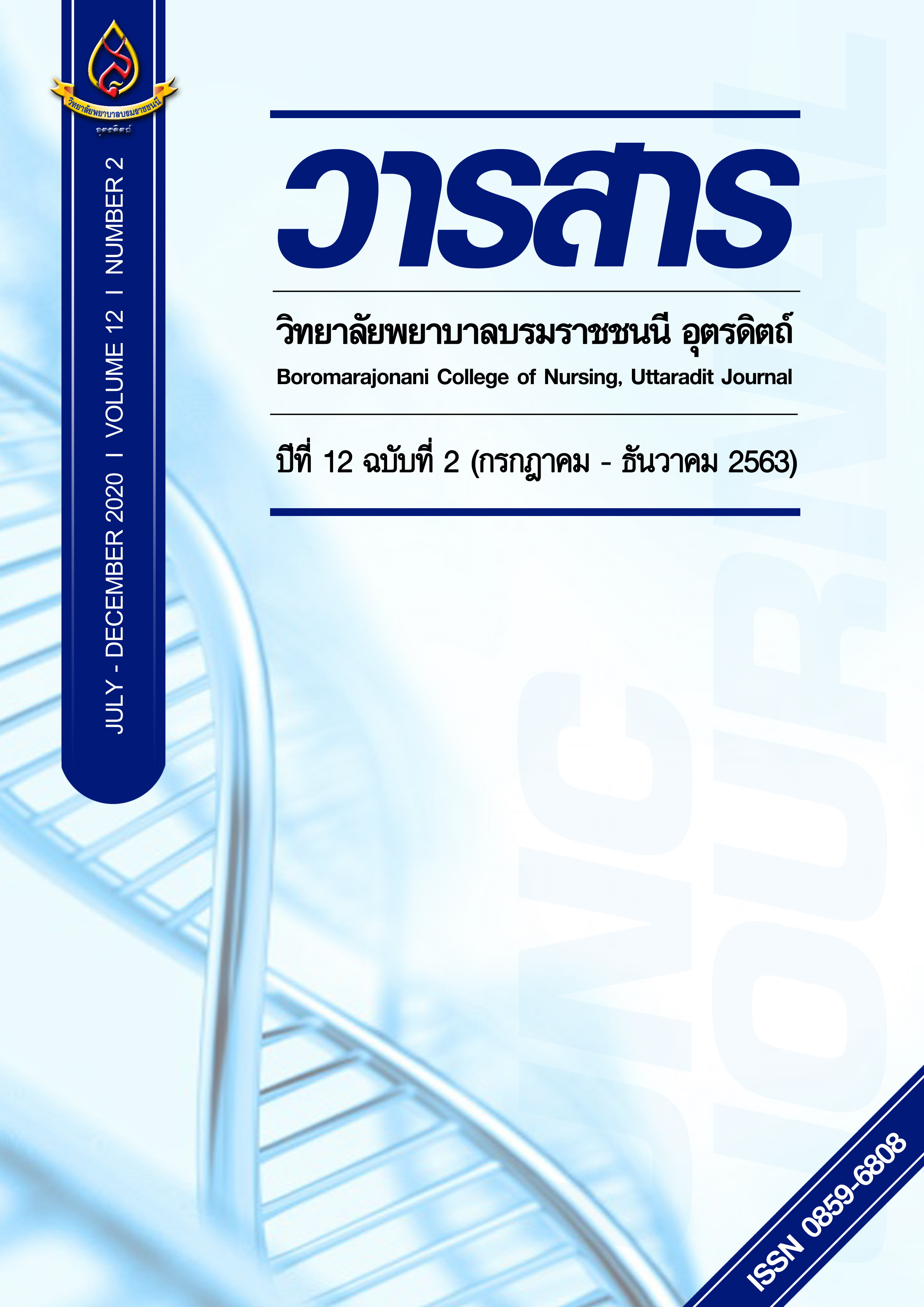ผลของโปรแกรมการดูแลเท้าร่วมกับสมุนไพรต่อพฤติกรรมการดูแลเท้าและอาการชาเท้าของผู้ป่วยเบาหวานเขตโรงพยาบาลทรายทองวัฒนา จังหวัดกำแพงเพชร
Main Article Content
บทคัดย่อ
การวิจัยกึ่งทดลอง (quasi-experimental research) แบบ three-groups, pre-posttest experimental design. เพื่อศึกษาผลของโปรแกรมการดูแลเท้าร่วมกับสมุนไพรต่อพฤติกรรมการดูแลเท้าและอาการชาเท้าในผู้ป่วยเบาหวาน ชนิดที่ 2 กลุ่มตัวอย่างเป็นผู้ป่วยเบาหวานที่มีผลประเมินการสูญเสียความรู้สึกเท้าอยู่ที่ระดับ 1 เป็นผู้ที่มีอาการชาเท้าและมีคะแนนการประเมินอาการชาเท้า (visual analog scale) เท่ากับ 2 และไม่มีแผลที่เท้า คัดเลือกกลุ่มตัวอย่างแบบเฉพาะเจาะจงตามเกณฑ์ที่กำหนด จำนวนทั้งหมด 89 ราย และสุ่มอย่างง่ายเป็นกลุ่มทดลองที่ได้รับโปรแกรมการดูแลเท้าร่วมกับสมุนไพร จำนวน 30 ราย กลุ่มควบคุมที่ได้รับโปรแกรมการดูแลเท้าร่วมกับน้ำอุ่น จำนวน 31 ราย และกลุ่มควบคุมที่ได้รับการพยาบาลตามปกติ จำนวน 28 ราย เครื่องมือที่ใช้ในการวิจัย ประกอบด้วย 1) โปรแกรมการดูแลเท้าร่วมกับสมุนไพร 2) แผนการสอน 3) คู่มือการดูแลเท้าร่วมกับสมุนไพร 4) คู่มือการดูแลเท้าร่วมกับน้ำอุ่น 5) แบบสอบถามความรู้ในการดูแลเท้า ทัศนคติในการดูแลเท้าพฤติกรรมในการดูแลเท้า 6) แบบบันทึกข้อมูลการตรวจประเมินการรับรู้ความรู้สึก วิเคราะห์ข้อมูลหาค่าความถี่ ค่าเฉลี่ย ร้อยละ และส่วนเบี่ยงเบนมาตรฐานและใช้สถิติ One-Way Repeated Measures (ANOVA)
ผลการศึกษา พบว่า 1) กลุ่มทดลองที่ได้รับโปรแกรมการดูแลเท้าร่วมกับสมุนไพร มีคะแนนเฉลี่ยของความรู้ ทัศนคติและพฤติกรรมการดูแลเท้าสูงกว่าก่อนการได้รับโปรแกรมฯ อย่างมีนัยสำคัญทางสถิติที่ระดับ .05 2) กลุ่มทดลองที่ได้รับโปรแกรมการดูแลเท้าร่วมกับสมุนไพร มีคะแนนเฉลี่ยของความรู้ ทัศนคติและพฤติกรรมการดูแลเท้าสูงกว่ากลุ่มควบคุมที่ได้รับการพยาบาลตามปกติ อย่างมีนัยสำคัญทางสถิติที่ระดับ .05 3) หลังการทดลองสัปดาห์ที่ 4 และ 12 กลุ่มทดลองที่ได้รับโปรแกรมการดูแลเท้าร่วมกับสมุนไพร มีอาการชาเท้าลดลง แตกต่างจากสัปดาห์ที่ 1 อย่างมีนัยสำคัญทางสถิติที่ระดับ .05 4) เมื่อเปรียบเทียบรายคู่ พบว่า กลุ่มทดลองที่ใช้โปรแกรมดูแลเท้าร่วมกับสมุนไพรกับกลุ่มที่ใช้โปรแกรมการดูแลเท้าร่วมกับน้ำอุ่นมีคะแนนเฉลี่ยของความรู้ ทัศนคติ และพฤติกรรมการดูแลเท้าแตกต่างกันอย่างมีนัยสำคัญทางสถิติที่ระดับ .05 และกลุ่มทดลองที่ใช้โปรแกรมดูแลเท้าร่วมกับสมุนไพรกับกลุ่มควบคุมที่ได้รับการพยาบาลตามปกติมีคะแนนเฉลี่ยของความรู้ ทัศนคติและพฤติกรรมการดูแลเท้าแตกต่างกันอย่างมีนัยสำคัญทางสถิติที่ระดับ .05 เมื่อเปรียบเทียบระหว่างกลุ่มที่ใช้โปรแกรมการดูแลเท้าร่วมกับน้ำอุ่นและกลุ่มควบคุมที่ได้รับการพยาบาลตามปกติ มีคะแนนเฉลี่ยของความรู้ ทัศนคติและพฤติกรรมการดูแลเท้าไม่แตกต่างกัน
Article Details
บทความหรือข้อคิดเห็นใดใดที่ปรากฏในวารสารวิจัยการพยาบาลและวิทยาศาสตร์สุขภาพ เป็นวรรณกรรมของผู้เขียน ซึ่งบรรณาธิการหรือสมาคมศิษย์เก่า ไม่จำเป็นต้องเห็นด้วย และบทความที่ได้รับการตีพิมพ์เผยแพร่ถือเป็นลิขสิทธิ์ของวารสารวิจัยการพยาบาลและวิทยาศาสตร์สุขภาพ
เอกสารอ้างอิง
2) Churpan, S. (2007). Factors influencing foot care behaviors in patients with type 2. (Master’s thesis). Chonburi: Burapa University. (in Thai).
3) Dempsey, P. A. & Dempsey, A. D. (1992). Data collection. In P. A. Dempsey, & A. D.Dempsey (Eds.), Nursing research with basic statistical applications. Boston.
4) Khumsub, S. (2018). The effects of footbath with Thai’s herb to peripheral neuropathy and blood circulation in patient with diabetes mellitus type 2. In
5) International Conference Graduate School Conference .Bangkok: SuanSunandha Rajabhat university. (in Thai).
6) Krairach, T., Jaisue, D., Matayaputorn, N. Siripitakchai, C., & Boranon, K. (2013). The effects of treading on kaffir Lines in egg tray for healing the toe numb symptoms in elderly with diabetic neuropathy. Journal of Nursing and Education, 6(2), 64-72. (in Thai).
7) Munprasong, K. (2012). The effects of empowerment program on level of depression in elderly. (Master’s thesis). Phitsanulok: Naresuan University. (in Thai).
8) Ogden, J., Karim, L., Choudry, A., & Brown, K. (2006). Understanding successful behaviour change: the role of intentions, attitudes to the target and motivations and the example of diet. Health Education Research, 22(3), 397-405.
9) Op-une, K., &Lertsatitthanakorn, P. (2011). Development of foot massage cream containing ginger oil for foot numbness and pain relief in diabetic neuropathy patients. Isan Journal of Pharmaceutical Sciences, 7(1), 28-38. (in Thai).
10) Paiboonworachat, S. (2015). Pain assessment. Retrieved (2017, March 13) form http://www.medcmu.ac.th/dept/anes/2012 (in Thai).
11) Parasin, N. & Khumful, S. &Thammachai,A. (2017). Immediate effect of thaiberbal hot pack treatment on pain and lower back flexibility: apilot study. Phayao.
Songklanagarind Medical Journal,35(3), 221-228. (in Thai).
12) Panjasri, P. (2007). Effect of planed instruction and modeling on practice, knowledge and control of blood glucose levels of diabetic patients. (Master’s thesis). Phisanulok: Naresuan University. (in Thai).
13) Potisat, S. (2013). Diabetes education for self-management. Nonthaburi: Institute of Medical Research and Technology Assessment. (in Thai).
14) Pragodpol, P. (2014). Study of the effect of acupressure massage with essential oils from bergamot and rollers on loss of sensation and numbness at the tip of the toe of diabetic patients. Retrieved (2017, March 13) form www.http://administer.pi.ac.th/uploads/eresearcher/upload (in Thai).
15) Reungthip, D. (2009). Effect of a diabetic foot care promotion program on rerceived self-efficacy for foot care and foot care behaviors among type 2 diabetic patients in a community hospital.(Master’s thesis). Bangkok: Thammasat University. (in Thai).
16) Tagrudjam, K. (2013). Outcomes of diabetic foot care coaching program for family caregiver with diabetic retinopathy patient (Master’s thesis). Chonburi: Burapa University. (in Thai).
17) Thanomsiang, N. (2017). Population and sample group. Retrieved (2017, March 13), from www.http://home.kku.ac.th/niko. (in Thai).
18) Thattanongchit, S. (2012). Effects of herbal foot bath in diabetic patients with foot numbness Sam Ngao hospital, Tak province. Nonthaburi: Kanchanabhishek Institute of Medical and Public Health Technology. (in Thai).
19) Trakulkarn, A. (2011). Effect of foot care program to foot care knowledge and behavior of older persons with diabetes mellitus type 2. Khonkan: Khonkan University. (in Thai).
20) World Health Organization. (2016). Diabetes. Retrieved (2017, March 13), form http://apps.who.int/iris/bitstream/10665/.../1/0/9789241565257_eng.pdf


